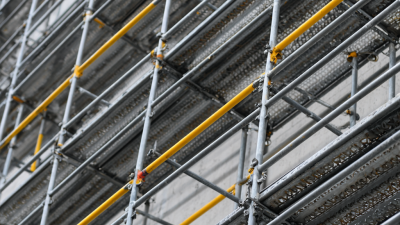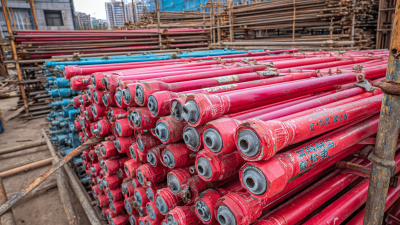 +86 18531741341
+86 18531741341
Leave Your Message
In the ever-evolving landscape of construction safety, innovative solutions play a crucial role in mitigating risks and ensuring the well-being of workers. One such advancement that has gained significant attention is the Cup Lock Scaffolding system. This method stands out for its versatility and robustness, offering a reliable framework for various construction projects. As the demand for safer and more efficient work environments continues to rise, understanding and implementing these innovative scaffolding solutions becomes increasingly important.
Cup Lock Scaffolding, known for its ease of assembly and structural integrity, provides a stable platform that enhances overall safety on construction sites. By utilizing this advanced system, contractors and project managers can significantly reduce the likelihood of accidents associated with traditional scaffolding methods. Furthermore, as we explore the ins and outs of Cup Lock Scaffolding, it becomes evident that its design not only facilitates quicker setups but also minimizes the risk of falls and collapses, which are common hazards in the construction industry.
This guide aims to delve into the various aspects of enhancing construction safety through Cup Lock Scaffolding. From understanding its key components and installation techniques to exploring best practices for usage, readers will gain invaluable insights that can help elevate safety standards on their job sites. Embracing these innovative solutions is essential for fostering a culture of safety and efficiency in the construction sector.

Innovative Cup Lock scaffolding solutions have revolutionized the construction industry by significantly enhancing safety measures on worksites. One of the standout features of Cup Lock scaffolding is its flexible design, which allows for easy assembly and disassembly. This quick setup reduces the exposure time of workers to potential hazards, streamlining operations while ensuring that all safety protocols are followed.
Moreover, the robust structure of Cup Lock scaffolding provides increased stability and load capacity. The unique locking mechanism prevents accidental dislodging of components, offering workers a secure platform. Regular inspections and adherence to maintenance schedules are crucial for maximizing safety.
**Tips:** Always ensure that scaffolding is erected on stable ground and that all components are checked for wear before use. Consider investing in protective gear that complements the innovative features of Cup Lock scaffolding to further safeguard workers from falls and accidents. Frequent safety training sessions can enhance worker awareness and preparedness for potential hazards.
Cup lock scaffolding has emerged as a crucial solution in enhancing construction safety across various projects. Its design allows for quick assembly and disassembly, contributing significantly to overall site efficiency. Numerous industry reports indicate that improper scaffolding practices lead to a high percentage of construction site accidents, emphasizing the need for reliable scaffolding systems. Implementing cup lock scaffolding not only reduces the risk associated with traditional scaffolding methods but also ensures compliance with safety regulations.
The benefits of utilizing cup lock scaffolding are manifold. This system is particularly valued for its versatility and stability, making it suitable for various applications in construction and energy projects. According to recent safety standards, scaffolding systems that adhere to EN1004 regulations demonstrate a lower incidence of failures, leading to safer working environments. Additionally, its ability to bear heavy loads while maintaining structural integrity significantly enhances worker safety on site. As the construction industry continues to prioritize safety, innovative solutions like cup lock scaffolding are becoming indispensable in reducing risks and improving project outcomes.
When comparing cup lock scaffolding to traditional scaffolding systems, several key advantages emerge that highlight the innovative design of cup lock solutions. Cup lock scaffolding utilizes a unique locking mechanism that provides enhanced stability and strength. Each vertical member is connected securely through a cup and pin design, which not only facilitates quick assembly but also ensures greater safety on construction sites. In contrast, traditional scaffolding often relies on less secure methods of connection, making it more susceptible to disassembly under stress or during adverse weather conditions.
Additionally, cup lock scaffolding boasts better adaptability and versatility. The modular nature of cup locks allows for various configurations, making it suitable for diverse construction projects, whether high-rise buildings or intricate architectural designs. Traditional scaffolding often requires more time and labor to adjust or reconfigure, increasing project timelines and labor costs. Furthermore, the streamlined design of cup lock systems contributes to a reduced risk of accidents, as fewer components mean less potential for human error during installation and disassembly, underscoring the importance of innovation in enhancing construction safety.
| Features | Cup Lock Scaffolding | Traditional Scaffolding |
|---|---|---|
| Weight Capacity | Higher weight capacity due to rigid design (up to 50kN per bay) | Lower weight capacity (up to 30kN per bay) |
| Assembly Time | Quick assembly with fewer components | Longer assembly time due to more components |
| Stability | Enhanced stability with locking mechanism | Less stable, requiring additional bracing |
| Safety Features | Integrated safety features to reduce accidents | Standard safety features; more prone to risk |
| Cost | Initial higher cost, but lower long-term costs due to durability | Lower initial cost, but higher long-term maintenance costs |
| Durability | Higher durability with galvanized steel | Lower durability; rust and wear issues |
Implementing cup lock scaffolding safely is critical to enhancing construction site safety. First and foremost, proper training for workers is essential. All personnel involved in the erecting and dismantling processes should undergo comprehensive training that covers the specific characteristics of cup lock scaffolding, including load capacity, assembly techniques, and safety protocols. Regular safety drills can reinforce the knowledge and skills required to handle this equipment effectively.
Additionally, conducting thorough inspections before and after scaffolding is erected can significantly reduce the risk of accidents. This includes checking for proper alignment, secure connections, and the condition of the components. Workers should be encouraged to report any signs of wear or damage immediately, fostering a culture of safety awareness. Moreover, adhering to regulatory guidelines and best practices for scaffold usage helps ensure that all safety considerations are met, ultimately creating a secure environment for all personnel on site. By focusing on training and regular inspections, the implementation of cup lock scaffolding can be both efficient and safe, significantly contributing to overall construction safety.
This chart illustrates the improvements in construction safety incidents after implementing innovative Cup Lock scaffolding solutions. The data shows the number of incidents reported before and after the adoption of these solutions across various project sites over a one-year period.
As construction sites evolve, so do the scaffolding solutions designed to enhance safety. Innovative cup lock scaffolding systems are at the forefront, incorporating advanced technology and design to mitigate risks associated with traditional scaffolding. These systems not only provide structural integrity but also facilitate easier assembly and disassembly, reducing the potential for accidents on-site. Future trends indicate a growing integration of smart technology that monitors safety parameters in real-time, ensuring that all workers are alerted to potential hazards promptly.
Tip: Regularly inspect scaffolding for integrity before use. Ensure all components are complete and secure, and that workers are trained adequately in scaffold operations.
Moreover, a focus on lightweight materials and ergonomic designs is reshaping the scaffolding landscape. These innovations not only enhance mobility but also decrease manual handling injuries, making working conditions more favorable for construction teams. The shift towards modular systems allows for greater versatility, accommodating various project sizes and complexities with ease.
Tip: Implement comprehensive training programs on the latest scaffolding technologies to keep your team informed and prepared for safe practices. Encouraging open communication about safety concerns can further contribute to a safer working environment.






